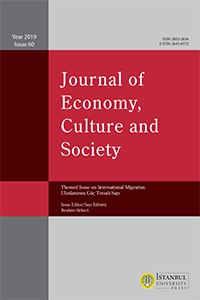Abstract
References
- Babaev, M. (1999). Methods for analyzing the influence of various factors of the socio-economic situation on the operational situation. Moscow: Moscow Publishing House.
- The state council the people’s republic of China. (2014). Exit and Entry Administration Law of the Peoples Republic of China. Retrieved fromhttp://english.gov.cn/archive/laws_regulations/2014/09/22/content_281474988553532. htm
- National Immigration Agency Republic of China (Taiwan). (2018). Foreign Residents by Nationality Ministry of the Interior. Retrieved fromhttps://www.immigration.gov.tw /5475/5478/141478/141380/152113/
- Hiskey, J., Malone, M., &Orces, D. (2014). Violence and migration in centralAmerica. Latin American Public Opinion Project Insights series. Retrieved fromwww.AmericasBarometer.org
- International Migration Outlook. (2017). Retrieved from https://www.oecd-ilibrary.org/social-issues-migrationhealth/international-migration-outlook-2017_migr_outlook-2017-en
- International Migration Statistics. Retrieved fromhttp://kostat.go.kr/portal/eng/surveyOutline /8/3/index.static The state council the people’s republic of China. (2013). Law of the Peoples Republic of the China on Control of the Entry and Exit of Aliens. Retrieved fromwww.lawinfochina.com/display.aspx?id=61&lib=law
- Mishchuk, S. (2016). The role of Chinese labor migrants in the socio-economic development of the southern regions of the Russian Far East. Russia and China: history and prospects for cooperation. Blagoveshchensk: BSPU Publishing House, 271-274.
- Nikitenko, I. (2013).Crime of foreigners: the state and problems with it (on the example of the Asian part of Russia). Oikumena, 48(3), 118–124.
- Federal Migration Service of Russia in PrimorskyKrai. (2015). Report “On the migration situation in the PrimorskyKrai and the main results of the activities of the Federal Migration Service of Russia in the PrimorskyKrai in 2015”. Vladivostok: Vladivostok Publishing House.
- Sakharov, A. &Voloshin, L. (1974). General theoretical questions of criminology. Questions of the fight against crime, 20(2), 14–32.
- Starchenkov, G. (1997). Labor migrations between east and west: the second half of the twentieth century. Moscow: Institute of Oriental Studies Publishing House.
- National Bureau of statistics of China. (2018). Statistical Communiqué of the People’s Republic of China on the 2018 National Economic and Social Development. Retrieved fromhttp://www.stats.gov.cn/english/PressRelease/ 201902/t20190228_1651335.html
Abstract
The subject of this study is processes of migration and how these relate to national, regional and international security: 1. A consideration of threats to the security of the Russian Far East in connection with external and internal migration. 2. Similar processes in the countries of the Northeast Asia region and their influence on the state of regional security as a whole. The purpose of the work is to analyze the above-mentioned phenomenon in Northeast Asia, as well as the impact of migration processes on regional security. Comparative and historical approaches are used in the research. These approaches made it possible to analyze the particularities of shaping the “agenda” of regional security in NEA and, in particular, in matters of migration. In addition, they facilitate an analysis of how national approaches to ensuring security in the region and threats in the field of migration (in parallel with them) have changed. While there is a sufficiently large number of studies on migration in general, there is currently no work in Russian political science that deals with the problems of migration in Northeast Asia in the context of regional and international security. Migration is a real, not a potential, security threat.
References
- Babaev, M. (1999). Methods for analyzing the influence of various factors of the socio-economic situation on the operational situation. Moscow: Moscow Publishing House.
- The state council the people’s republic of China. (2014). Exit and Entry Administration Law of the Peoples Republic of China. Retrieved fromhttp://english.gov.cn/archive/laws_regulations/2014/09/22/content_281474988553532. htm
- National Immigration Agency Republic of China (Taiwan). (2018). Foreign Residents by Nationality Ministry of the Interior. Retrieved fromhttps://www.immigration.gov.tw /5475/5478/141478/141380/152113/
- Hiskey, J., Malone, M., &Orces, D. (2014). Violence and migration in centralAmerica. Latin American Public Opinion Project Insights series. Retrieved fromwww.AmericasBarometer.org
- International Migration Outlook. (2017). Retrieved from https://www.oecd-ilibrary.org/social-issues-migrationhealth/international-migration-outlook-2017_migr_outlook-2017-en
- International Migration Statistics. Retrieved fromhttp://kostat.go.kr/portal/eng/surveyOutline /8/3/index.static The state council the people’s republic of China. (2013). Law of the Peoples Republic of the China on Control of the Entry and Exit of Aliens. Retrieved fromwww.lawinfochina.com/display.aspx?id=61&lib=law
- Mishchuk, S. (2016). The role of Chinese labor migrants in the socio-economic development of the southern regions of the Russian Far East. Russia and China: history and prospects for cooperation. Blagoveshchensk: BSPU Publishing House, 271-274.
- Nikitenko, I. (2013).Crime of foreigners: the state and problems with it (on the example of the Asian part of Russia). Oikumena, 48(3), 118–124.
- Federal Migration Service of Russia in PrimorskyKrai. (2015). Report “On the migration situation in the PrimorskyKrai and the main results of the activities of the Federal Migration Service of Russia in the PrimorskyKrai in 2015”. Vladivostok: Vladivostok Publishing House.
- Sakharov, A. &Voloshin, L. (1974). General theoretical questions of criminology. Questions of the fight against crime, 20(2), 14–32.
- Starchenkov, G. (1997). Labor migrations between east and west: the second half of the twentieth century. Moscow: Institute of Oriental Studies Publishing House.
- National Bureau of statistics of China. (2018). Statistical Communiqué of the People’s Republic of China on the 2018 National Economic and Social Development. Retrieved fromhttp://www.stats.gov.cn/english/PressRelease/ 201902/t20190228_1651335.html
Details
| Primary Language | English |
|---|---|
| Subjects | Sociology |
| Journal Section | Research Article |
| Authors | |
| Publication Date | October 22, 2019 |
| Submission Date | March 1, 2019 |
| Published in Issue | Year 2019 Issue: 60 |

